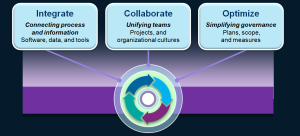In my previous two posts titled “System of Systems Engineering: Part I – Challenges” and “System of Systems Engineering: Part II – Overcoming the Challenges“, I discussed the challenges organizations face with complex System of Systems (SOS) engineering programs along with the potential solution for this challenge using the IBM Rational Collaborative Lifecycle Management (CLM) platform.
This post is based on a paper I written about four years ago when I was part of the IBM Software Group covering the Rational solutions. Therefore, it is biased towards the IBM offerings in the software delivery space. The content of the paper was based on several other IBM intellectual capital (IC). Excerpts from the ICs are included as-is. While the recommended tooling addresses the full scope of the software delivery lifecycle from inception to production, it is not necessary that you should view the solution as an “all or nothing” proposition. The intent is to highlight the problem areas and make you aware of how the IBM Rational solution addresses them.
System of Systems Engineering: Proposed Solution Benefits
The IBM Rational proposed solution provides team members of the SOS program greater confidence . The solution promotes project success through continuous integration, automation and test-driven development.
It provides the following benefits:
- Provide team independence – Each team may adopt their own process for software development that best suit their needs.
- Clarification of the requirements – Developing user stories. Often times, the requirements are miss-understood and needs clarifications before committing to the development of the sub-system. The method to address this challenge is through the use of story boards, a capability included as part of the solution.
- Facilitate team collaboration – The solution manages relationships among artifacts and provides a rich communications infrastructure for project teams.
- Support your agile processes – The collaboration tool includes planning templates for Scrum, RUP, Waterfall, OpenUP frameworks and others to make it easier for you to support or extend your agile or iterative process adoption.
- Greater visibility, productivity and resource utilization – The solution helps enable team members to easily access the real-time information they need to keep projects moving.
- Enhanced productivity – With this solution, team members can work together more efficiently, regardless of their location.
- Supports more effective resource utilization – The solution provides greater visibility into your teams’ workloads, so you can more effectively utilize your resources.
- Engaging through Project transparency- Provides greater visibility into individual and team work. The solution allows for automatic tracking of project progress with dashboards that include real-time project statuses.
- Identify defects earlier in the software delivery lifecycle, when they are less costly to fix – The solution helps reduce the time it takes to fix new defects. Once a defect is detected, unit tests related to the defects are easily created specific to the case that is causing the problem without the need for a full build saving tremendous and valuable time.
- Accelerate development cycle times using out-of-the-box process workflows, common services and a unified application lifecycle management (ALM) architecture.
- Automated Governance – With the solution, you can implement and enforce the use of best practices, including agile methodologies.
- Improve the predictability of project outcomes – The solution reduces total cost of administration as it leverages a highly scalable, centralized solution featuring high availability and security-rich project access control.
- High value automated testing – The solution provides capabilities to manually test parts of the project that are still in development. It also provides the capabilities to automate parts that are stable to avoid rework.
- Supports a broad range of products from multiple vendors
IBM recognizes SOS programs use a range of software delivery products from multiple vendors and open-source communities, often complemented with internally developed custom tools. The integrations between these products are generally product-to-product solutions that provide tenuous connections based on unique tool-to-tool interfaces. When one tool needs to access data from another tool, a bridge is required. This bridge is implemented through a vendor-specified API, which is often tied to a specific platform or language. When a tool needs to record additional information, yet another bridge is required. This tightly coupled network of custom bridges can be vulnerable to everyday disturbances such as changes or upgrades to the underlying operating system or API revisions from vendors.
[AdSense-C]
To lower integration barriers for businesses and tool providers alike, IBM started the OpenServices for Lifecycle Collaboration (OSLC; http://open-services.net) project. This project is a multi-vendor effort that defines a uniform set of protocols and specifications based on existing open standard technologies. The specifications define how resources from loosely coupled tools can be shared in a consistent way. This type of integration provides an effective, light weight integration allowing any product to integrate with the proposed solution.
About the Author
 Sami Joueidi holds a Masters degree in Electrical Engineering and an Enterprise Architecture certification from Carnegie Mellon. He has over 20 years of experience as a technical leader of complex IT projects for Fortune 500 firms, in diverse roles such as Systems Integrator, DevOps, Cloud Architecture, Enterprise Architecture and Software Development & Release Management. He guides customers on how to leverage the latest technology trends to their advantage and helps them with their Cloud adoption strategies.
Sami Joueidi holds a Masters degree in Electrical Engineering and an Enterprise Architecture certification from Carnegie Mellon. He has over 20 years of experience as a technical leader of complex IT projects for Fortune 500 firms, in diverse roles such as Systems Integrator, DevOps, Cloud Architecture, Enterprise Architecture and Software Development & Release Management. He guides customers on how to leverage the latest technology trends to their advantage and helps them with their Cloud adoption strategies.
© Sami Joueidi and www.cafesami.com, 2015. Excerpts and links may be used, provided that full and clear credit is given to Sami Joueidi and www.cafesami.com with appropriate and specific direction to the original content.


Do you like to comment?